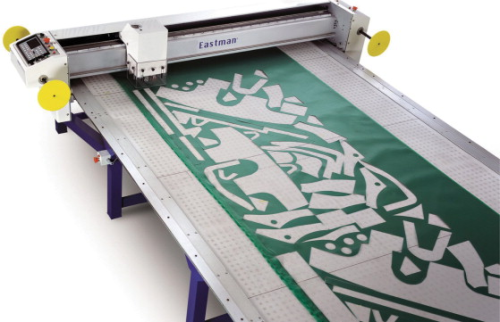
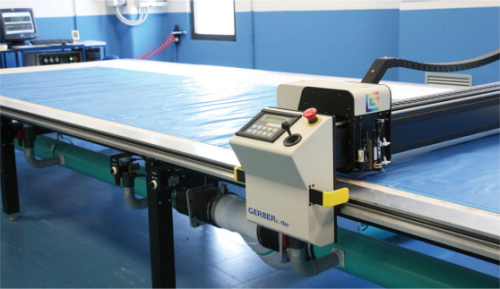
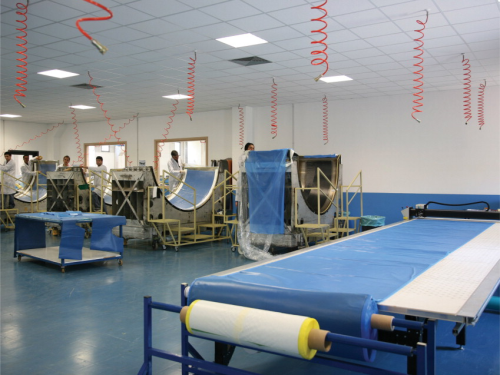
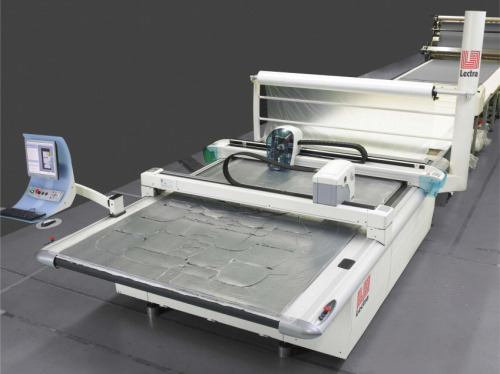
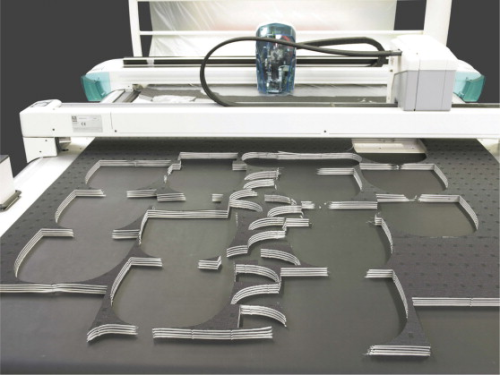
Automated cutting equipment can speed up production times and reduce labour costs. Software can optimise use of material to reduce waste – an important consideration for high priced reinforcements and prepregs. Designs can be quickly modified. Composite materials can be cut in complex patterns, quickly, accurately and consistently, and with better edge quality. Cut materials can be marked to make identifying parts (and kitting) easier. Suppliers of automated cutting systems and their associated equipment and software have developed solutions for the traditional textiles markets (fashion, furniture) and are now focusing on the growing markets of industrial textiles and composites. Depending on the user's requirements, a wide range of options are available for cutting rolled materials (single or multiple ply) or sheet materials, including prepregs, dry carbon/aramid/glass fabrics, sheet moulding compound (SMC), and core materials.
Keeping up with demand
Audio Composite Engineering, Escondido, California, USA, has been building composite loudspeakers since 1993. When it comes to loudspeaker enclosures, there are a number of advantages to having high strength paired with reduced weight, and this is an area where carbon fibre materials contribute significantly. Products employing composite technology benefit from a high stiffness-to-weight ratio, superior acoustic properties, lower weight and greater weather resistance compared to conventional enclosure materials. Multiple skins of carbon fibre layered over a Nomex® honeycomb core form a highly rigid enclosure, with reduced parasitic cabinet resonance, increased low frequency output, and substantially less sound radiating from the back and sides of the enclosure. Audio Composite Engineering installed an Eastman Machine Company cutting system in January 2001, for a number of reasons.
“We needed to cut down on our workplace injuries, and needed to keep up with our demand,” reports Eric Elliott, Audio Composite Engineering's Operation Manager. “It replaced eight people 40 hours a week each. Now two people at 32 hours a week can do the same thing. It had repeatability and we never have to store an aluminium template or have the wrong generation of template used.” The company uses an Eastman M9000 Static System to cut a variety of materials, including carbon and Kevlar fabrics, polyvinyl chloride (PVC) foam, and polyethylene sheets. It is also used to scribe rough templates and to drill holes in Lexan polycarbonate sheet. A variety of blade types are used on the automated cutting system to cut these materials - standard drag knife, custom drag knife, custom drill head, and rotary cutter. The static cutting table used at Audio Composite Engineering has an active cutting width of 78 inches (2 m) and a table length of 28 ft (8.5 m). The system cuts up to 200 yards (around 180 m) of material a day (8 hour shift). Audio Composite Engineering was previously cutting with manually-operated tools. The Eastman M9000 is designed for single or low-ply layer cutting. It has a standard three-tool cutting head and a standard porous plastic table top. It is capable of marking, cutting, drilling and punching virtually any flexible material at speeds of up to 60 inches/second (152.4 cm/s) and has an accuracy of ±0.015 inches (±0.4 mm), with higher accuracies available. The material to be cut is spread across the static table and its internal vacuum system ensures material hold-down for cutting accuracy. EasiCut™ cutter control software is Windows-based and designed to be easy to use. Users can import files into EasiCut, identifying cutting requirements such as material type, velocity, pressure, tool type, etc. The user outlines the area to be cut with the mouse and with the simple press of a button cutting begins. Various marking, tool head, and material handling options are available to enhance the system. As well as a comprehensive line of fully automated, computerised cutting and plotting systems, Eastman, with headquarters in Buffalo, New York, USA, offers a wide range of hand-held and manually-operated fabric cutting machines. Approximately 40% of the company's automated cutting systems business is in the composites industry, where customers include companies supplying the aerospace, marine, recreational (sporting goods) and wind energy markets.
Eastman expects an increase in its composites business in the future as more companies are using lightweight materials and are implementing better processes for their production. Composite applications tend to require extremely precise parts/pieces and also use very expensive materials. Eastman's automated systems offer a solution to those that require accurate cutting, but can also minimise material waste (using the software capabilities) and also reduce overall production time.
Optimised production
Noting the continuing growth of the global aerospace market, Michele Miccariello, an Italian engineer with significant expertise in composite materials, decided in 2001 to start the CAM company. CAM operates as a supplier of composite aerospace components and is capable of managing highly-specialised manufacturing processes requiring the latest production techniques. CAM's headquarters and operations are located in Paolisi, near Brindisi in the Southern Italian region of Puglia. Using a range of composite materials including prepreg carbon, Kevlar, fibreglass and others, CAM manufactures parts for aircraft and for assembly of other composite and light-alloys structures. After completing a significant level of technology investments in July 2004, CAM began operations in September of that same year. The company has continued to invest to expand its technology capabilities. In its first year of operation CAM installed two autoclaves, a clean-room facility, a laser projection system, a refrigerated cell, several ovens for various manufacturing processes and a 5-axis machining system. In 2005, CAM acquired a DCS 2500 cutting system from Gerber Technology, which it uses for cutting fibreglass, Kevlar, carbon prepregs, Nomex and other materials. The cutting system has contributed to a significant increase in CAM's production capacity and has resulted in considerable savings in time and money.
“We never thought we could realise a return on our investment so quickly,” says Miccariello. “The Gerber cutting system has optimised our production process by shortening the time previously required for cutting. It also saves a considerable amount of material thanks to its highly efficient software nesting process. Such performance has led us to plan additional investments for a DCS 2500 cutting system to be housed in a climate-controlled environment." The DCS 2500 is single/low-ply cutting system featuring cut speeds up to 66 m/minute and an acceleration of 1.5 g. The system is engineered for cutting a broad variety of materials at 1/10 mm accuracy. It can be configured in two work zones in order to optimise throughput by overlaying cutting operations with the collection of previously cut pieces, or the preparation of the next set of materials to be processed. The DCS 2500 head carries three cutting tools and a marking pen. The system is powered by Gerber's CutWorks software, which features an easy-to-use Windows interface. In the future CAM plans to install a non-destructive ultrasound system for quality control. It also intends to expand its current facility and add further CNC and laser work centres. CAM is already certified by Alenia Aeronautica, Alenia Aermacchi, Alenia Aeronavali and Augusta Westland as a gold-level supplier for component parts, stampings and tooling. The company is presently undergoing the Boeing supplier accreditation process. These companies have endorsed CAM as a supplier based on its ability to satisfy stringent requirements relative to product quality and delivery times. CAM's strategy is to continually enhance its operational capabilities with the acquisition of new equipment and the continued development of additional know-how. In the future the company is likely to consider broadening its activities to other application sectors, beyond aerospace. The plan is to leverage the expertise acquired in such a complex and demanding market as the aerospace industry.
New manufacturing challenges
Lectra, the French-based provider of software, CAD/CAM equipment and related services, offers an integrated suite of solutions dedicated to the manufacture of composite components. These include the DesignConcept 3D conception tool for creation of complex models, feasibility analysis, flattening from 3D to 2D, and cost estimation as well as VectorTechTex cutting systems for single and multiple ply cutting. The company latest VectorTechTex machine is suited to processing a variety of materials from carbon prepregs, multiple layer cutting of dry materials like fibreglass as well as some core materials such as phenolic honeycomb. One company employing Lectra's cutting technology is Toyota Boshoku America, a supplier of automotive interior systems and filters. The company produces complete systems that include seats, door trim, ceiling material, and carpeting. The Toyota Boshoku America Research & Development facility in Novi, Michigan, develops prototypes for selected Toyota and General Motors vehicles. As manufacturers seek to meet customers' demands for quiet, comfortable, stylish interiors, car seat systems have become complex and more difficult to manufacture. New features such as occupant detection systems, seat heating and cooling systems, and entertainment systems are now built into seats. Product development schedules have also shortened—the time between initial concept and prototype is now approximately four weeks, or about half of what it was just a few years ago. In the past, Toyota Boshoku America engineers developed prototypes by digitising foam seat shapes and developing patterns, which were then hand-cut from leather, vinyl or other materials. This was time consuming and lacked the accuracy required to meet the automotive industry's stringent tolerances. Cutting a single trim cover could take two to three hours. Toyota Boshoku America looked for a cutting solution that would enable engineers to accelerate prototyping and ensure that the patterns developed would work the same in production as they did in prototyping. After evaluating several cutting solutions, it chose Lectra's VectorAutoFX automated cutter. During its prototyping process, Toyota Boshoku America uses Lectra's Formaris pattern-making software for digitising and defining pattern pieces. The model is imported into Lectra's DiaminoTechTex application, where markers are created and nested. Markers are sent directly to the VectorAuto automated cutting system for optimal material usage and high productivity. Toyota Boshoku America adheres to strict cutting tolerances in its production environment – the team performed cutting tests with the VectorAuto and then checked the actual dimensions of the cut parts using its CAD system measurement tools. “The cut parts were more accurate than our plotter,” reports Jon Gill, Lead Engineer for the Trim Engineering Group. “We are able to perform tight radius cuts with a smooth, continuous radius, instead of the jagged cuts you see with knife cutters. Our parts are well within our tolerances and we obtain much better fitting of our patterns to seat shapes.” Improved cutting accuracy reduces the number of design changes that are often required at the production facility because of cutting errors or production difficulties. Production teams can now evaluate trim cover designs while they are being prototyped and know that the parts will be identical in production. Gill has seen large time savings as well. What used to take several hours now takes only minutes, and the company can cut 5-10 trim covers at a time for prototyping.
